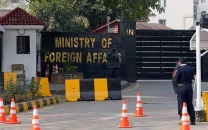Daniel Pearl's parents say their son slain to create fear
In their review plea, they say Omar Sheikh's past must be taken into consideration

American journalist Daniel Pearl’s parents on Friday told the Supreme Court that the motive behind the brutal murder of their son was not personal enmity but was clearly to use it to intimidate not only the Pakistani government but other countries and organisations as well.
In April last year, the Sindh High Court (SHC) set aside the detention of four men – including British-born Pakistani Ahmed Omar Saeed Sheikh – who were convicted by an anti-terrorism court in 2002 for Pearl's murder.
The verdict was challenged by the PPP-led Sindh government and Pearl’s parents in the top court.
Last month, in its 2-1 majority judgment in the Pearl murder case, the Supreme Court held that the entire evidence in the case was full of doubts and the prosecution had failed to prove the guilt of the four accused, including Sheikh.
The parents of the Wall Street Journal journalist then filed a review petition against the verdict.
“The respondent No 2 [Sheikh) was arrested in the year 1999 in relation to the kidnapping of foreigners in India and remained in an Indian prison till December, 1999,” read the petition submitted by Pearl's parents to the court through their counsel Faisal Siddiqi.
Also read: Move Sheikh to rest house: Supreme Court asks Sindh
“Thereafter, the respondent No 2 was released from an Indian prison and sent to Afghanistan in exchange for passengers aboard on a hijacked airliner,” it added.
"It is submitted that under Article 21, Qanun-e-Shahadat Order, 1984, the past criminal history of an accused person as evidence can be relied upon.”
The petition further read that it had never been the petitioners’ case that Sheikh should be punished for his crimes previously committed in India.
“Therefore, there is no need to produce documents related to the said case in evidence in the trial court and confront respondent No 2 with these documents.”
The petition added that foreign courts’ judgments have persuasive value, therefore, the past criminal activities of respondent No 2, as documented by the Indian Supreme Court in judgment reported as AIR 2003 SC 4427, can be taken into consideration, as it has persuasive value.
“It is pertinent to note that the terror of respondent No 2 as an international terrorist was so much that the trial of the case was conducted in the circumstances of continuous threats to the witnesses and prosecution counsel and there was even a threat to blow up the court premises because of which the trial was transferred to Anti-Terrorism Court, Central Prison, Hyderabad.”
Also read: Pearl murder mystery
The petitioners informed the court that the brutal murder was a result of international terrorism and the principle of the standard of proof as well as the benefit of doubt in cases of international terrorism have to be applied keeping in context that the nature and type of evidence available in such cases could be equated with those involving non-terrorism crimes.
“Hence, the majority judgment has erred in making the aforementioned observation. It is most respectfully and most humbly submitted that for the aforementioned facts and reasons, the impugned majority judgment suffers from a misreading and non-reading of the evidence on the record and misapplication of the law,” the petition read.
The review petition stated that one of the central questions involved in this case was whether or not the benefit of doubt in favour of the accused would trump all other issues for duties imposed on the court.
“The right to fair trial, as provided under the Constitution, 1973, does not cast an artificially heavier onus on the prosecution to meet standards of proof beyond human capacity,” the plea added.
“It is submitted that the courts have a dual duty, both a duty to ensure that no innocent person is convicted and also to ensure that no guilty person is acquitted and it is on the basis of both these duties towards the innocent as well as the victim that the courts should examine the evidence accordingly rather than primarily focusing on and simply identifying doubts in the evidence to acquit the accused.”
In the present case, the petition added, the administration of criminal justice had to be dynamically balanced upon fair trial without prejudice to the accused as well as due weightage to the prosecution evidence without being swayed by illusory notions, subjectively structured upon hypothetical beliefs.
Also read: SC orders release of Daniel Pearl murder case accused
“However, the respondent No 2 was acquitted of all charges on the ground of the benefit of doubt, as there was some contradictory evidence available on the record and in total disregard of irrefutable evidence available on the record for conviction,” the petition read.
“[The] delay in the [registration of FIR] is never per se fatal if evidence in the case is trustworthy and reliable or if the complainant is able to explain the delay.”
It was submitted that there were unavoidable and valid reasons for the complainant’s non-appearance as a witness and therefore, the complainant had no opportunity to explain the delay.
“Moreover, if there is trustworthy and reliable evidence in the case then it cannot be discarded merely on the basis of delay in initiating the FIR. Hence, the impugned majority judgment has erred in making the aforementioned observations.”
The review petition further stated that the prosecution had proved the charge of kidnapping/abduction for ransom of the deceased person, under Section 365-A, PPC, 1860, against respondent No 2.
First, the identification of respondent No 2 in a test parade proved that Pearl was abducted by him on January 23, 2002. Secondly, other witnesses had corroborated that Sheikh was last seen with witness No 1.
Thirdly, the digital evidence brought on record linked Shiekh and co-accused Fahad Naseem with the offence of kidnapping/abduction for ransom. The digital foot-print and evidence produced by witnesses No 14 and 18, two totally independent and professionally qualified persons, proved beyond reasonable doubt that an email dated January 30, 2002, containing ransom demands and information regarding the abduction of Pearl was sent through co-accused Fahad Naseem’s internet connection.
“The digital evidence when read with the confessional statements of co-accused Fahad Naseem and Salman Saqib, proved beyond any shadow of doubt that the co-accused Fahad Naseem and Salman Saqib sent the email containing ransom demands on Sheikh’s instructions,” the plea read.
“In view of the aforementioned, an adverse inference can be drawn against the respondent No 2 for failing to provide any reasonable explanation regarding the aforementioned pieces of evidence against him in his statement under Section 342, CrPC, 1898, as a mere bold evasive denial regarding his involvement in the crime of kidnapping/abduction for ransom of Pearl is not legally sufficient to escape criminal culpability.”
It was submitted that it did not matter if the trial court had not passed separate sentences for each offences, such inadvertent mistake on the part of learned trial court, was not fatal to the prosecution case and was a curable defect as the appellate court had inherent power to make such orders as may be necessary for the ends of justice.


















COMMENTS
Comments are moderated and generally will be posted if they are on-topic and not abusive.
For more information, please see our Comments FAQ